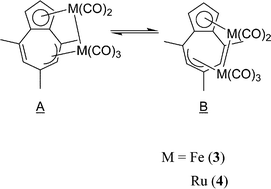Experimental and theoretical aspects of the haptotropic rearrangement of diiron and diruthenium carbonyl complexes bound to 4,6,8-trimethylazulene†
Abstract
The haptotropic rearrangement of dinuclear

* Corresponding authors
a
Division of Applied Molecular Chemistry of Institute for Material Chemistry and Engineering, Kyushu University, Kasuga, Fukuoka, Japan
E-mail:
nagasima@cm.kyushu-u.ac.jp
b Analytical Center of Institute for Material Chemistry and Engineering, Kyushu University, Kasuga, Fukuoka, Japan
c Department of Molecular and Materials Science, Graduate School of Engineering Sciences, Kyushu University, Kasuga, Fukuoka, Japan
The haptotropic rearrangement of dinuclear

 Please wait while we load your content...
Something went wrong. Try again?
Please wait while we load your content...
Something went wrong. Try again?
K. Tsuchiya, K. Ideta, K. Mogi, Y. Sunada and H. Nagashima, Dalton Trans., 2008, 2708 DOI: 10.1039/B719331A
To request permission to reproduce material from this article, please go to the Copyright Clearance Center request page.
If you are an author contributing to an RSC publication, you do not need to request permission provided correct acknowledgement is given.
If you are the author of this article, you do not need to request permission to reproduce figures and diagrams provided correct acknowledgement is given. If you want to reproduce the whole article in a third-party publication (excluding your thesis/dissertation for which permission is not required) please go to the Copyright Clearance Center request page.
Read more about how to correctly acknowledge RSC content.
 Fetching data from CrossRef.
Fetching data from CrossRef.
This may take some time to load.
Loading related content
